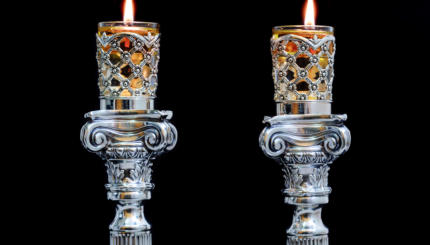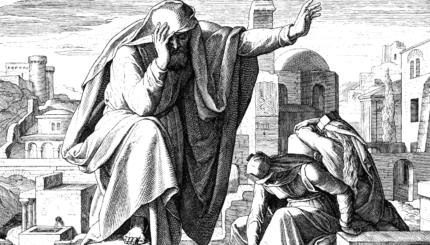Like all the festivals of the Jewish calendar, Purim as we know it today is the product of a long history of development.
Ostensibly a commemoration of national deliverance from danger, we should have expected solemn ceremonies of thanksgiving such as characterize Passover and Hanukkah. The victory over Haman is, however, distinguished by a unique mood of high-spirited frivolity, colored by high alcoholic content and a general tendency to make light of matters which would be treated more reverently at other seasons.
Original Solemnity
The earliest descriptions of Purim celebrations, from the Second Temple and Mishnaic eras, offer no indication of the irreverence that we associate with the festival. The emphasis is on the formal reading of the Scroll of Esther, which was to be conducted with great care and seriousness.
To the best of my knowledge none of the familiar themes of drinking, parody, etc., are mentioned in Talmudic sources emanating from the Land of Israel. In fact the chief Palestinian rabbinic exposition of Esther, the midrash Esther Rabbah, seems to take every possible opportunity to emphasize the dangers of wine, incorporating a lengthy tract on the virtues of temperance.
The events of the Megillah are interpreted as reflections of the religious behavior of the Jews of the time, and within the context of broader historical themes, especially the destruction of the First Temple and the beginnings of the building of the Second (which the Rabbis believed was delayed by Ahashverosh and Vashti).
It was the Jews of Babylonia who seem to have introduced some of the more frivolous customs into the observance of Purim. Two main factors can be traced to the Babylonian Talmud: “Purim-Torah” and the encouragement of drunkenness.
In the Babylonian Talmud
An exceptional passage in the Bavli (Babylonian Talmud, Hullin 139b) serves as a model for subsequent “Purim-Torah”–that is, playfully using some of the far-fetched methods of talmudic logic and Biblical exegesis in order to reach absurd conclusions.
The passage in question relates how a visiting rabbi was challenged to find references to Mordecai, Esther, Haman, and Moses (!) in the Pentateuch. The sage responds to the riddles with audacious, clever puns. For example, ignoring the traditional vocalization, he finds an allusion to Haman in Genesis 3:11: “Is it from (hamin) the tree…” (also hinting at the villain’s hanging); and to Esther in Deuteronomy 31:18, where God says, “I will surely hide (haster ‘astir) my face” (recalling Esther’s refusal to disclose her origins to the king).
Typically, some of the later commentators approached the talmudic passage without full appreciation of its humorous intent. Thus Rashi gravely tries to justify the need to find an “allusion” to Moses’ name in the Torah.
Or to take another example, the later custom of donning masks and costumes on Purim–a practice which is first reported in Provence in the early 14th century, and later achieved popularity under the influence of the German Fastnacht celebration and the Italian carnivals–was afterwards tied to the idea of God’s “hiding his face” as found in the Talmud!
In contrast to the approach taken by the Palestinian sources, the Babylonian Talmud records the famous dictum of the noted sage Rava (Megillah 7b): “A man is obligated to get drunk on Purim to the point where he can no longer distinguish between ‘Cursed is Haman’ and ‘Blessed is Mordecai.'”
Here, too, later authorities had trouble accepting the ruling at face value. For an arch-rationalist like Maimonides it was unimaginable that the halacha [Jewish law] could be condoning such actions; hence he re-interpreted the ruling to refer to drinking only enough to fall asleep. Some authorities understood that the statement was rejected by the Talmud, a view which it indicates by juxtaposing to it an incident wherein Rabbah slaughters Rabbi Zera while under the influence. (Rabbah is able to revive his colleague, though the latter politely refuses an invitation to the next year’s festivities).
Medieval Parodies
From these Talmudic beginnings we can trace the development of a whole genre of Purim parodies, wherein Jews would affectionately poke fun at the world of Talmud and halacha. From the 12th century, Jews in Italy, southern France (Provence) and elsewhere were producing parodies on the Talmud, liturgy ,and other familiar pillars of Jewish life.
A typical “Purim Tractate” (Masekhet Purim) might follow the form of the Tractate Pesahim which deals with the regulations of Passover, except that all the stringent laws concerning the removal of leaven are now applied to water and non-alcoholic beverages, which are not to be tolerated on the holiday.
A special roster of biblical and rabbinic authorities populates these works. Alongside such drunkards as Noah and Lot we might encounter the prophet Habakbuk (“the Bottle”); as well as Rabbi Shakhra (“Drunkard”), or the commentary of Rasha (“Wicked”). In modern times especially, the format has been used to satirize a variety of social phenomena, from American Judaism to Israeli politics
It might be my imagination, but I have noted that in recent years it has become almost impossible to find these parodies, which used to be routinely reprinted before Purim. This might be indicative of an excessively defensive mood that has overtaken religious Jewry.
Particularly among German Jews there also developed the institution of the “Purim-shpiel,” a rowdy play on the Megillah story (or other theme) traditionally performed on Purim. Absorbing a number of different traditions, from the German theater as well as from Jewish exegesis, these productions took great liberties with plot and characterization, such that Mordecai might appear as a pathetic buffoon, Haman as a tragic figure, and so on. Such irreverence could of course be tolerated only at Purim time.
To German Jewry we also owe the adoption of the Hamantasch, an adaptation of the German mahn-tash (“poppy-pocket”) pastry, given a new meaning for the occasion.
Our custom of sounding noisemakers at the mention of Haman’s name is also a version of an old practice, which took on different forms through the generations. The earliest sources (from the writings of the Babylonian Ge’onim) speak of burning effigies of Haman on a bonfire. In medieval Europe children would write Haman’s name on stones or wood blocks, and bang them until the name was erased.
In our observance of Purim we are thus drawing from a long line of historical precedents and developments.
Reprinted with permission of the author.
Purim
Pronounced: PUR-im, the Feast of Lots, Origin: Hebrew, a joyous holiday that recounts the saving of the Jews from a threatened massacre during the Persian period.
Talmud
Pronounced: TALL-mud, Origin: Hebrew, the set of teachings and commentaries on the Torah that form the basis for Jewish law. Comprised of the Mishnah and the Gemara, it contains the opinions of thousands of rabbis from different periods in Jewish history.
halacha
Pronounced: hah-lah-KHAH or huh-LUKH-uh, Origin: Hebrew, Jewish law.



